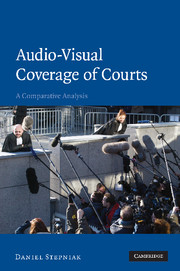1 - Introduction
Published online by Cambridge University Press: 27 October 2009
Summary
An overview of the history of the debate
Whether media organisations should be permitted to photograph or otherwise record vision and/or sound of court proceedings has been debated for as long as such technology has existed.
Thus the debate in Britain dates back to the introduction of press photography, while in the United States the issue first gained prominence through the filming of trials for cinema newsreels.
Several factors account for the disquiet caused by the media's incorporation of visual images in courtroom reporting, which led such visual coverage to be prohibited in Britain and virtually banned in the United States. Early courtroom photography was undoubtedly disruptive and distracting to participants, not only because it involved the use of cumbersome and obtrusive technology, but also because it was novel. Courts and other authorities also deemed visual coverage undesirable because it facilitated unprecedented levels of public access, further fuelling interest in and debate of judicial proceedings.
Disquiet at the potential impact of such intrusive publicity on courtroom participants and on public respect for legal institutions has continued to dominate the debate long after technological advances eliminated the bases of concerns relating to physical distraction and disruption. The belief that respect and confidence in the judiciary is promoted and protected through the maintenance of judicial mystique and detachment has also served to provide a rationale for a denial of electronic media access to proceedings, even where the interests of parties and participants cannot be adversely affected.
- Type
- Chapter
- Information
- Audio-visual Coverage of CourtsA Comparative Analysis, pp. 1 - 10Publisher: Cambridge University PressPrint publication year: 2008



